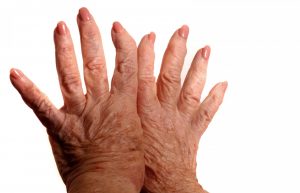Guest Blog: Lindsay Munden, DNP, RN, FNP-BC
Psoriasis
Psoriasis is a lifelong disease that causes scaling and inflammation of the skin. The condition starts beneath the skin’s surface and is triggered by an overactive immune system, which causes skin cells to be over-produced and accumulate on the skin’s surface faster than normal. This process is called cell turnover, and in psoriasis may take a few days instead of weeks. This causes the formation of thick, red, itchy, flaky patches with silvery scales known as plaques. While any part of your body can be affected, psoriasis most often occurs on the elbows, knees, scalp, back, face, palms, and feet.
Risks
According to the American Academy of Dermatology (2015) about 7.5 million people in the United States have psoriasis. Anyone can get the disease, but it occurs more often in adults.
- Age: Adult men and women are affected equally. The two peak ages at onset are during the late teens to early 20s and in the late 50s to early 60s.
- Genetics: Psoriasis has a strong genetic influence, with one-third of patients with psoriasis reporting having a family member with the disease.
- Environmental Factors: Trauma to normal skin, repeated friction, infections, stress, fatigue, warm humid climates, changes in weather that dry the skin, and certain medications may trigger psoriasis flare-ups.
Causes
The primary cause of psoriasis remains unknown. Research has indicated that psoriasis is caused by genetic influences and a dysfunction of the immune system. Although, psoriasis plaques may look contagious, you cannot get the condition from someone that has the disease.
Symptoms
Symptoms can range from mild to severe and are often recurring. Itchy, red, inflamed and dry scaly plaques distributed symmetrically over areas of bony prominences such as the elbows and knees are characteristic of the disease. The joints, nails and scalp may also be affected. As with other chronic conditions, symptoms may flare or worsen for a few months and then subside for a period of time.
Diagnosis
Psoriasis may be hard to diagnose because it can be confused with other skin diseases. Usually your healthcare provider will make a diagnosis based on a thorough skin examination. Biopsy is seldom necessary because the clinical features of psoriasis are so distinctive. Plaque psoriasis is the most common form, but patients typically have one or more types.
Treatment
The goal of therapy is to control the symptoms and clear the plaque lesions.
For mild to moderate psoriasis, topical medications (those applied directly to the skin) and phototherapy (light therapy) are the mainstays of treatment. For severe psoriasis, systemic treatments are recommended. Sometimes, combining topical, light and systemic treatments leads to the best results.
Topical Medication Options:
- Topical steroids are widely used because they help reduce inflammation. Generally, a very potent topical corticosteroid preparation is applied two to three times daily for 2 weeks and then decreased to a lesser potency for maintenance therapy long term.
- Coal tar works by causing the skin to shed dead cells from its top layer and slow down the growth of new skin cells. This effect decreases scaling and dryness. Coal tar is applied once or twice daily and is not well favored due to the potential for staining of the clothes and skin.
- Anthralin works by slowing down the production of skin cells. This type of medication is applied to the skin for a prescribed period of time and then rinsed away, with increased increments until the skin is healed which may take a couple of weeks.
- Topical immunomodulators are medications which work by decreasing the body’s immune system to help slow down the growth of the psoriasis plaques.
- Vitamin D3 derivatives regulate cell growth and decrease lymphocyte (cells which play a role in the regulation of the immune system) activity. The medicine comes in a form of an ointment which is typically applied twice daily.
Phototherapy:
Phototherapy with ultraviolet-B (UVB) light is effective in the treatment of psoriasis lesions. This type of treatment reduces DNA synthesis of skin cells. Phototherapy can produce symptom-free periods of up to 2-4 months. UVB therapy units are often available at dermatologist offices and the use of commercial tanning beds (with both UVA and UVB lights) is not recommended. Dermatologists may recommend consistent light therapy 3-5 days a week for 2 to 3 months.
Systemic Medications:
Systemic therapy is reserved for patients that have severe or incapacitating disease. These medications are prescribed by expert specialists such as dermatologists or rheumatologists because they have a risk for serious side effects.
More Information:
National Psoriasis Foundation www.psoriasis.org
National Institute of Arthritis and Musculoskeletal and Skin Diseases www.niams.nih.gov
American Academy of Dermatology https://www.aad.org/

